12 Puffballs and Earthstars
Puffballs bear their spores inside a round, oblong, or pear-shaped sac called the spore case. Many puffballs lack a stalk, others have a narrowed sterile base, while a few have a prominent stem. Earthstars are modified puffballs in which the spore case sits at the center of several starlike rays.
Most puffballs are edible when firm and white inside, but care must be taken to distinguish them from amanita “eggs,” which show an embryo of cap, gills, and stalk when sliced open vertically (see this page). As puffballs mature, the interior becomes mushy or slimy and finally dry and powdery. The spore dust is disseminated by wind and rain, sometimes through a small hole that forms at the top of the puffball.
More than 100 kinds of puffballs and earthstars occur in western North America, including many prairie and desert species; only a few are depicted here. For a more comprehensive treatment, see MD 677–764.

A fungo bat and puffballs.
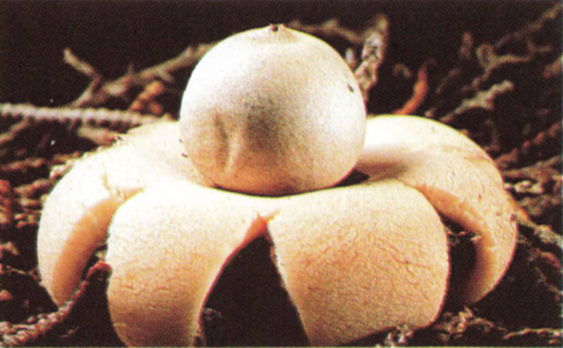
A woodland earthstar (Geastrum saccatum).
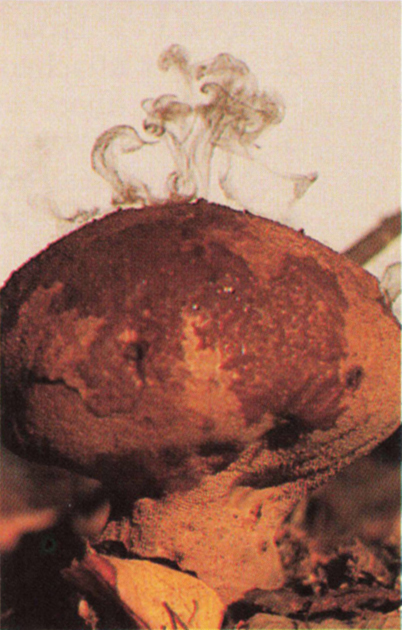
“When it rains, it spores”: mature “puff”-balls emit clouds of spore dust when pelted by raindrops, squeezed, or blown by the wind.
Tumbling Puffball (Bovista plumbea)
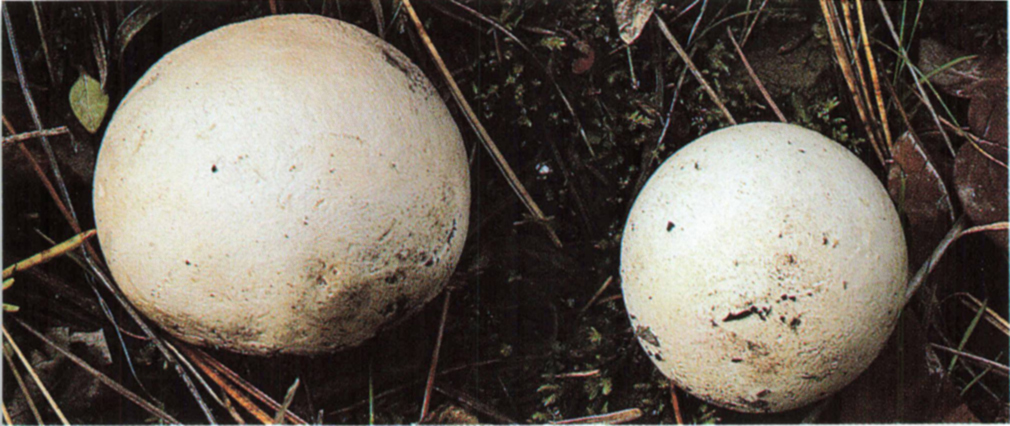
Key Features:
1. Mushroom more or less round, marble-sized to golfball-sized (<2″ broad).
2. At first attached to ground by a small patch of dirt-binding fibers, without a narrowed base or stalk.
3. Exterior without warts or spines, white when young but brown or lead-colored when old.
4. Interior solid and white when young, brown and powdery when old.
5. Old mushroom with a large mouth at the top.
6. Growing in grassy or open ground.
Other Features: Skin thin and papery when mature, often with a metallic luster.
Where: On ground in meadows, lawns, and other open places; widespread and common. When old it often tumbles about in the wind.
Edibility: Edible when firm and white inside, but bland.
Note: A slightly larger species, B. pila, is attached to the ground by a small cord rather than a patch of fibers. Many other small to medium-sized puffballs can be found in our forests, fields, and deserts. Although edible when young, they tend to be bland. Some, like Lycoperdon (below), have a narrowed stemlike base. See MD 690–698.
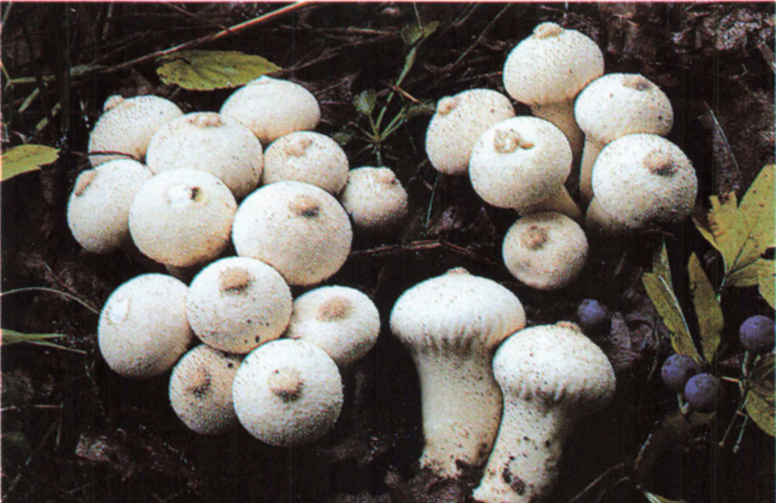
Lycoperdon perlatum is a common small to medium-sized puffball. Note the narrowed stemlike base and small hole that forms at the top in age.
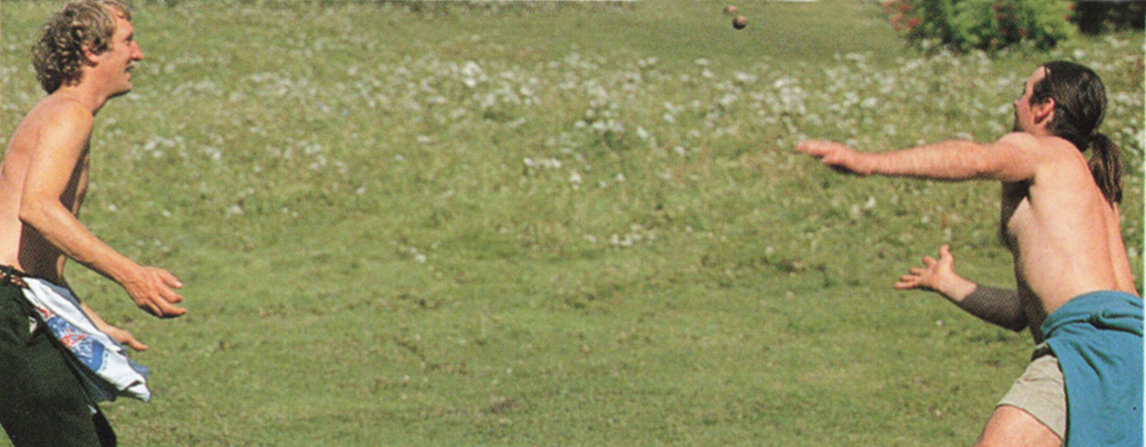
Puffrut
Native Americans used puffballs as food, medicine, incense, and decoration, to staunch bleeding, to make ceremonial necklaces, and in various games. The object of puffrut (shown above and below) is to keep the puffball aloft as long as possible. It can be played with any small puffball, but for the purists only a fully mature Bovista plumbea (inset) will do. Although puffrut is an obvious precursor of modern games like volleyball, badminton, and hackysack, its origins are shrouded in mystery. The derivation of the name is also unclear. “Rut” is an obvious reference to the grunting sounds of participants (reminiscent of rutting rams or seals), but does “puff” refer to the huffing and puffing of the “rutters” or the puffing of the “ball” as it is ever-so-lightly batted back and forth?
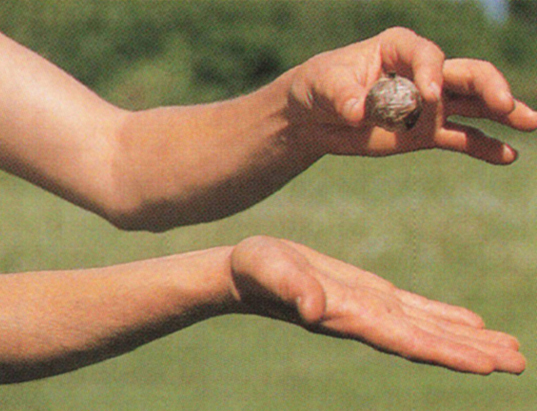

For best results, keep your eye on the “ball” at all times.
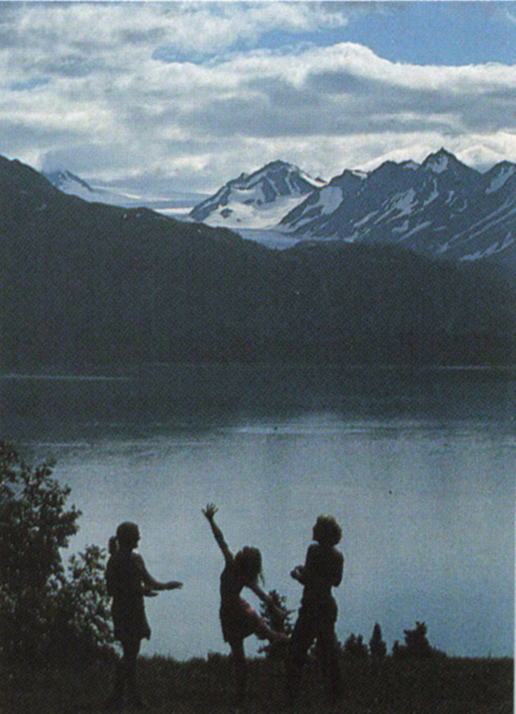
Puffrutting in the early morning light.
Western Giant Puffball (Calvatia booniana)

Key Features:
1. Mushroom large (at least 8″ broad when fully grown).
2. Mushroom round or oblong (like a flattened sphere), without a prominent narrowed base or stalk.
3. Exterior with broad warts or plaques, white to pale tan.
4. Interior solid and white when young, powdery and brown or olive-brown when old.
Other Features: Skin fairly thick, eventually flaking away in plaques or disintegrating; interior with a slimy yellow intermediate phase before becoming powdery.
Where: Alone or in groups on ground in pastures and on hillsides, along roads, in sagebrush flats and other open places. Fairly common inland, but replaced on the West Coast by a slightly smaller, smoother giant puffball (see this page).
Edibility: Edible when firm and white inside; avoid those showing traces of yellow or green, as they may cause stomach upsets. The firm, tofu-like flesh is best cubed and simmered in soups, or sliced and then breaded and fried.
Note: Giant puffballs can usually be told by their size alone. In prairie regions they can weigh as much as 50 pounds and have been mistaken by passing motorists for herds of grazing sheep. Passing mushroomists, on the other hand, are more likely to mistake herds of grazing sheep for giant puffballs! See MD 682–684 and plates 184, 186.

F. Dutra and C. booniana.
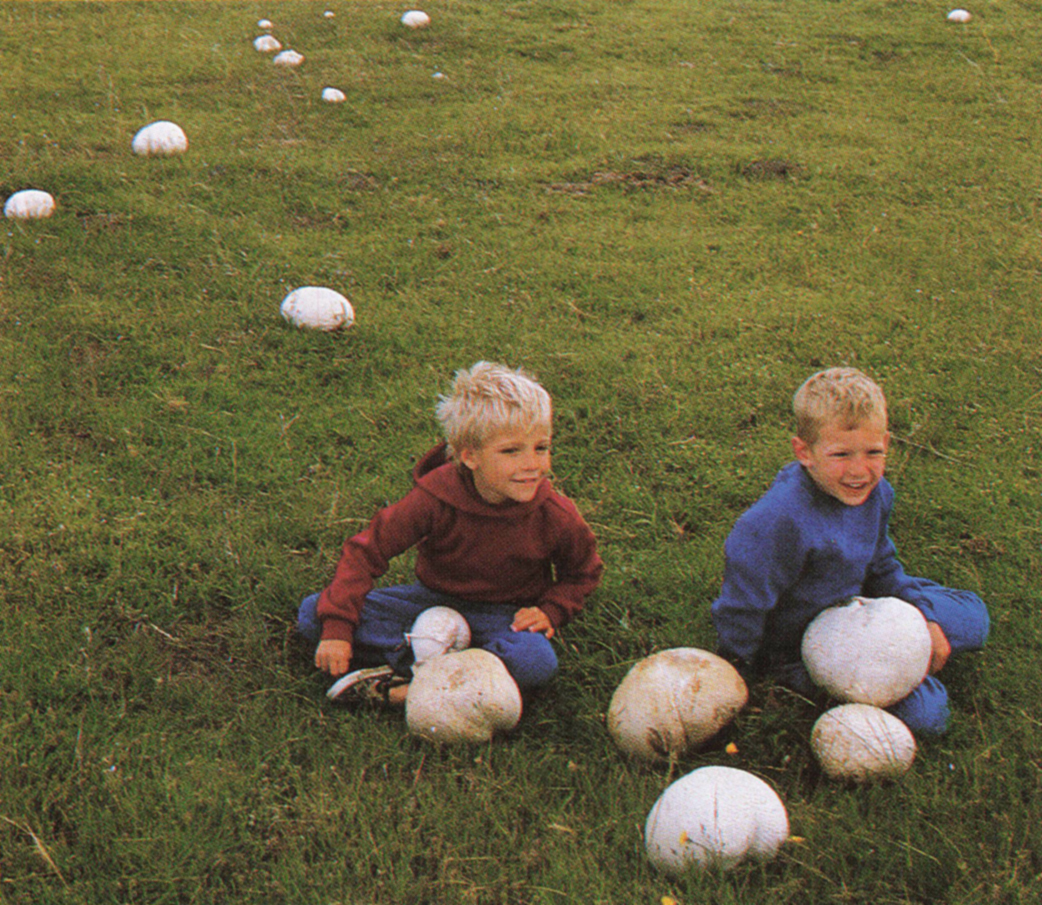
The giant puffball (Calvatia gigantea or a closely related species) is common on the West Coast, especially in the spring. It is smoother and slightly smaller than the western giant puffball, and is edible when firm and white inside.
Sierran Puffball (Calvatia sculpta)
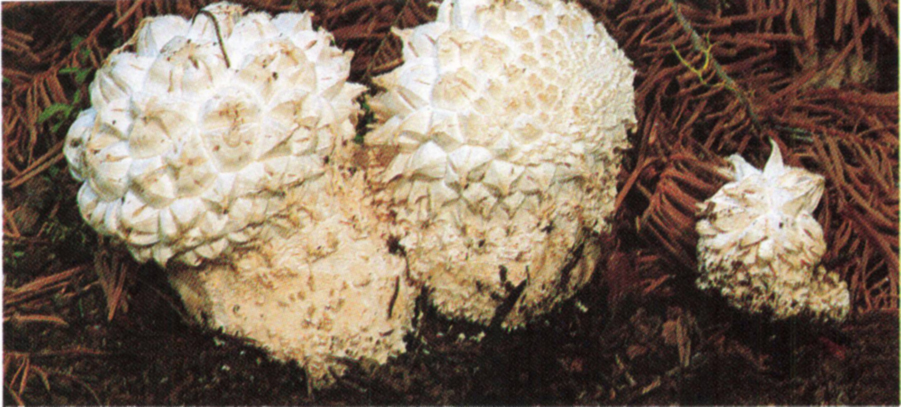
Other Names: Sculptured Puffball.
Key Features:
1. At least 4″ high when fully grown, broader at top than at base (but may be nearly round when young).
2. Exterior white when young, covered with large pointed warts or “peaks” resembling meringue.
3. Interior solid and white when young, brown or olive and powdery in old age (with slimy intermediate phase).
4. Growing in mountains.
Other Features: Medium-sized to fairly large; warts often pyramidal, their tips often fused to adjacent tips; skin eventually flaking away or disintegrating (small hole not forming at top); narrowed base sterile (without spore dust inside).
Where: On ground under mountain conifers and in clearings; common in the Sierra Nevada and Cascades, absent or infrequent elsewhere. It is often encountered in the spring but also fruits in the summer and fall.
Edibility: Usually good when firm and white inside, but sometimes with a slightly unpleasant, iodine-like flavor. See the western giant puffball for cooking suggestions.
Note: The spectacular warts are the hallmark of this mountain puffball. Another mountain species, Calbovista subsculpta, has less impressive warts but is otherwise similar. Be sure not to confuse these puffballs with warty young amanitas. The puffballs reveal solid flesh when sliced vertically, while an amanita will show an embryo of cap, gills, and stalk. See MD 684–685 for more information.


Girls Just Wanna Have Fungus
Dashing Roberto Mortillero has thrown the perfect party: Shaggy Manes, Coccoli, Blewits, Bleeding Milk Caps, Matsutake, and the Prince, each with a human escort. As often happens in California, the party ends when the host is carried out on a stretcher. The following account of the Mushroom Party is taken from the Diary of Valley Unit “Gagme” Sappa, and is reprinted with permission of the author’s roommates, who are dying to see her face when she finds out it’s missing.
Dear Diary: That total babe Roberto had this party tonight — I mean, if you could call it a party, like no keg! But all these babes came anyway, and I had on like this radical sequined tube top with my leopard-spotted spandex pedal pushers and high-heeled sandals, and like the babes musta thought I looked real Boss cuz they really gave me the hairy eyeball.
Like it started when I went to the hardware store cuz I read this article that all the babes go there, but like, you go up to a babe and say “Woah, that’s a big pipe — I like a babe with a big pipe,” and like he says he’s gotta go home and paint the crib! So I see a poster for this thing called the Fungus Fair, and I go there, which is okay cuz there’s a bunch of babes hanging out, you know like not jock types, like eeooo I can’t stand big pecs on a guy, know what I mean? I mean like outdoorsy babes, you know, kind of like the Marlboro Man but skinnier and with dirty clothes and leaves and stuff in their hair. So I buy this mushroom book, right? It’s called Mushrooms Demystified, like it tells how to get all the gross myst off of mushrooms, it’s written by this Demystifier guy who’s kinda like a Ghostbuster I guess. So anyways, I go outside and find a bunch of slimy mushrooms and go back to the Fair and ask this babe called Roberto about them, and we get talking and I say, like does he know about any good parties and he says come to his house Saturday night.
This party at Roberto’s, like everyone’s porking out on mushrooms, right? And that’s all, cause these babes, if they’re munching mushrooms, they don’t care what you’re wearing or how much Nautilus you do or nothing. And then Roberto gets like totally sick, and it’s like gag me with a Stinkhorn, he’s losing his dinner all over the place, and this babe called Norris says someone poisoned Roberto, and then this short fat guy in a raincoat falls out of a tree in Roberto’s yard and lands right on top of Norris! So like the ambulance is pulling away and Gag me, there’s Norris and this fat guy bleeding all over the place! Somebody says they’re both dead, so it’s like, Time to find another party.
So I say to this babe called Onree (I think he’s like Foreign, from Oregon or someplace), if he wants to come to my place, I’ll show him my Giant Puffballs. So like we step over Norris and the fat guy who fell out of the tree, and me and this babe Onree go to my place and wouldn’t you know it, those sub-normal cows I live with, they won’t leave us alone for a second, and we end up talking! Like Gag me, like I wanna spend Saturday night talking!…
—edited by Mike O’Ryzal, with Monty Ray Pyne
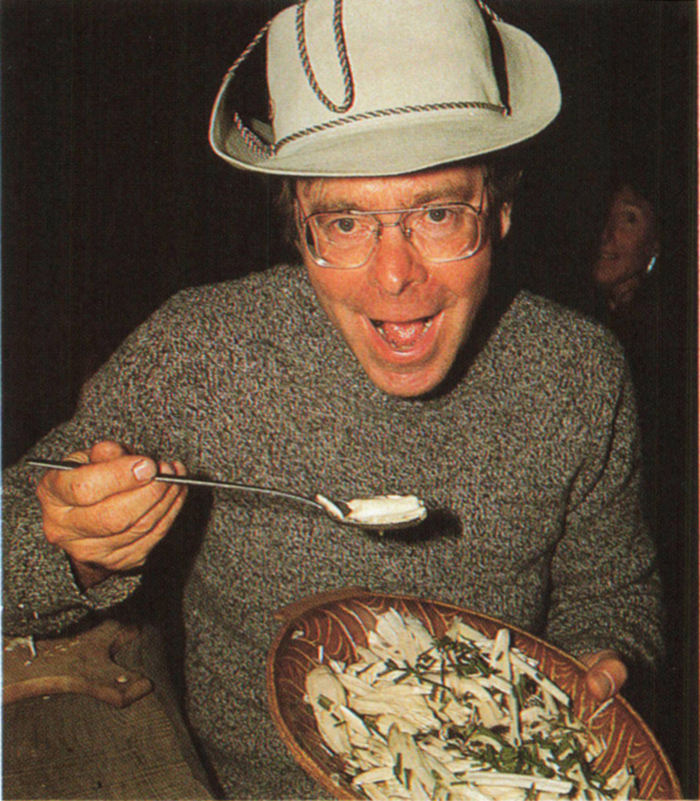
“These babes, if they’re munching mushrooms, they don’t care what you’re wearing or how much Nautilus you do or nothing…”
Earthstar (Astraeus hygrometricus)
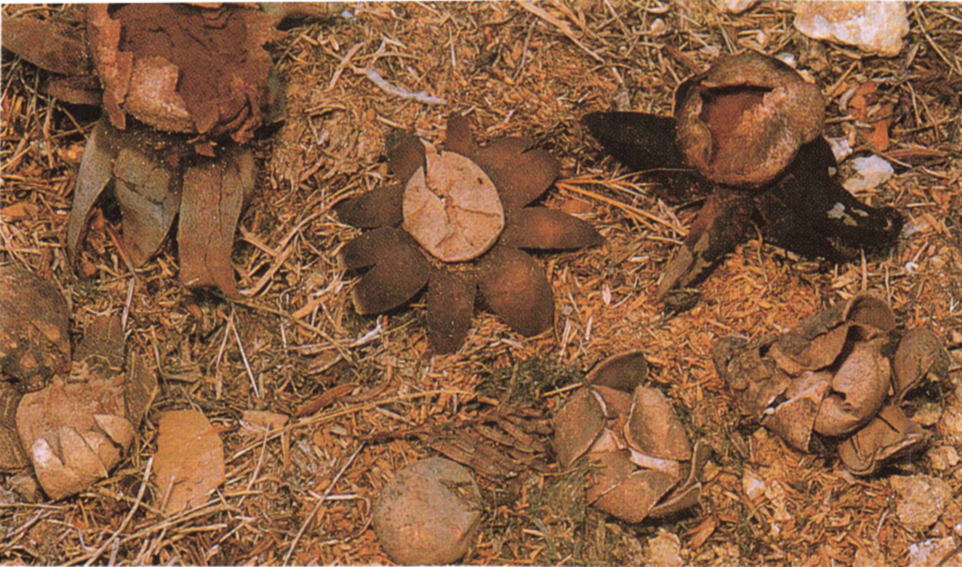
Other Names: Hygroscopic Earthstar, Barometer Earthstar.
Key Features:
1. Mushroom up to 3″ broad when expanded, consisting of a round to somewhat flattened spore case seated at the center of 6-16 starlike rays.
2. Rays hygroscopic (folding over the spore case and completely hiding it in dry weather, then unfolding to expose the spore case when moistened).
3. Open rays not standing on their tips.
4. Spore case not mounted on a short stalk.
5. Surface of spore case roughened by fine particles.
Other Features: Rays very tough, their surfaces often cracked; spore case eventually rupturing through a hole or slit at the top and then disintegrating.
Where: On ground in deserts, roadside ditches, pastures, under shrubs or trees, etc.; widespread and common.
Edibility: Not edible when mature. In Thailand, the underground, truffle-like “eggs” are considered a delicacy.
Note: Many earthstars cannot close once open. A. pteridis is a large western version of A. hygrometricus. See MD 669-706 for more information.

A constellation of earthstars. These species lack the “earthstartling” ability to open and close at will, but are notable for standing on the tips of their rays: Geastrum fornicatum (three on left), G. pectinatum (the “beaked” one on the right), and G. quadrifidum (small, foreground).
Dead Man’s Foot (Pisolithus tinctorius)

Other Names: Dyemaker’s False Puffball, Stone Puffball, Bohemian Truffle, Pisolithus arrhizus, Pisolithus arenarius.
Key Features:
1. Mature mushroom brown, brittle, and dusty, protruding from the ground like a dusty stump, half-rotted root, or ball of dried-up dung.
2. Young mushroom roundish to pear- or club-shaped.
3. Interior of young mushroom containing many small seedlike capsules imbedded in a dark sticky substance (slice it vertically as shown on this page).
4. Seedlike capsules disintegrating into brown powder with age, the disintegration process beginning at the top of the mushroom and progressing downward.
Other Features: Medium-sized to large; exterior yellowish, brownish, purplish, or blackish; base of mushroom often narrowed like a stalk; volva absent.
Where: In disturbed or exposed soil near trees and shrubs, along roads and trails, in old pastures, etc.; widespread, but especially common in Oregon and California. It often bursts through pavement.
Edibility: Not edible.
Note: This bizarre mushroom forms a symbiotic relationship with the rootlets of various trees and shrubs, enabling the trees to survive in poor soil by helping them absorb nutrients. It is also an excellent dye mushroom, yielding gold, brown, and black. See MD 712–713 for more information.
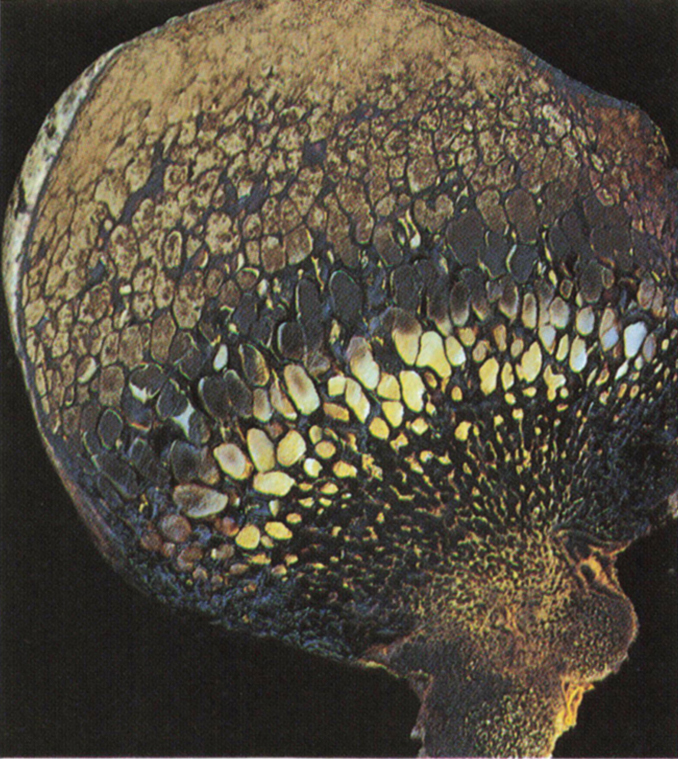
A young specimen sliced open to show the spore-bearing capsules inside.
Pick-A-Lithus
Every September a pesky Pisolithus pokes up in the patio shown below, displacing a different brick each time (below) as its mycelium moves around in search of nutrients. Inspired by the surfeit of government-sponsored lotteries, the local mushroom club decided to hold a “fung raiser” called “Pick-A-Lithus” (lithus, stone) in which people bought the brick or bricks that they thought would be hoisted by the Pisolithus the following year. All the bricks were sold, and the winner received a “cord” of dried morels.

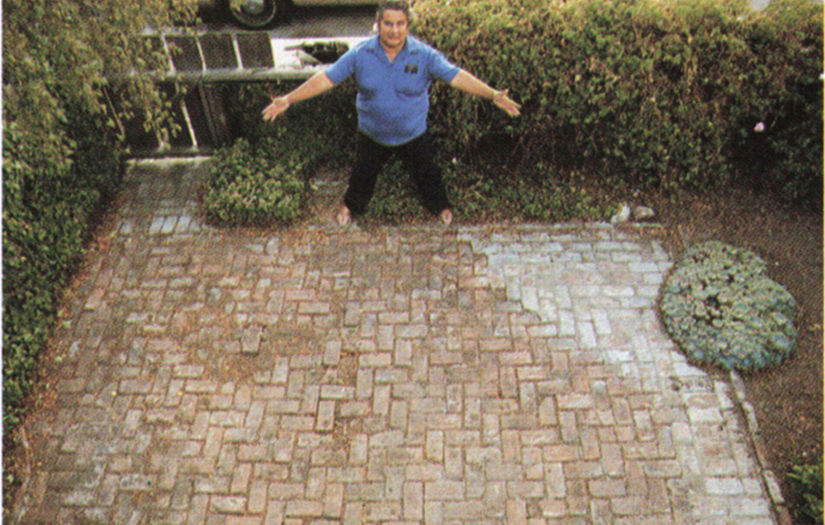
Dead Man’s Hand (Scleroderma geaster)
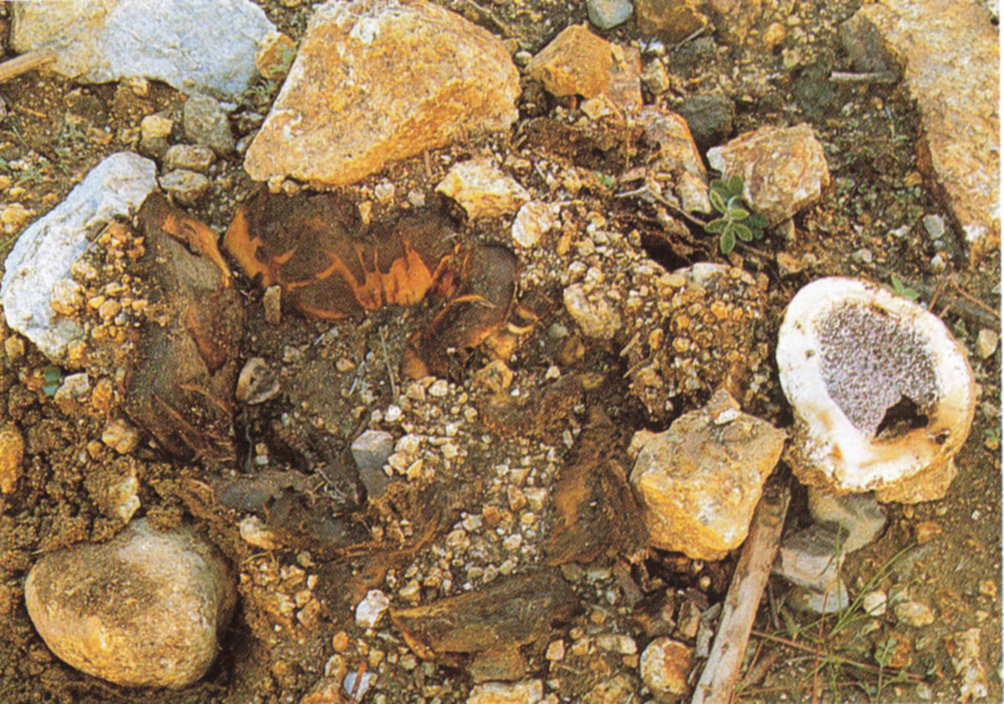
An expanded specimen is at center; the young one at lower left has been sliced open (right) to show the thick, hard skin and dark interior.
Other Names: Earthstar Scleroderma, Scleroderma polyrhizon.
Key Features:
1. Young mushroom resembling a hard puffball (i.e., more or less round) but with a very thick (⅛–⅜″) skin that splits into several rays or “fingers” when mature.
2. Mushroom more than 4″ broad once the rays spread out.
3. Interior hard and white when very young but becoming gray to purple-black while still firm, finally brown and powdery after the skin splits open.
4. Growing in disturbed or exposed soil, sand, or asphalt.
Other Features: Exterior smooth or slightly scaly but without warts, whitish to yellowish, usually dirty or sandy; inner surface (upper surface of rays) brown to blackish.
Where: Usually half-buried in sand, asphalt, or poor soil along roads or in other disturbed areas; widespread, especially common in California.
Edibility: Poisonous, causing gastrointestinal distress.
Note: After splitting into rays, this mushroom might remind someone with a morbid imagination of the outstretched palm of a buried corpse, especially when found near a dead man’s foot, as is often the case. S. texense is a similar but scalier species. Other sclerodermas are smaller or do not split open so dramatically. They are easily mistaken for edible puffballs, but have a thick, hard skin and firm, purplish to black interior. See MD 707–711 and plate 190.
Desert Shaggy Mane (Podaxis pistillaris)

Key Features:
1. Mushroom with a cap and stalk.
2. Cap oval or tall and narrow, white to tan.
3. Stalk tough, extending all the way through the cap to the top.
4. Gills absent; interior of cap with irregular plates when young, eventually disintegrating into reddish-brown to blackish-brown spore powder.
5. Volva absent (i.e., no sack or cup at base of stalk).
6. Growing in deserts and other dry places.
Other Features: Medium-sized; cap scaly or smooth, eventually tearing or splitting lengthwise; interior at first white, soon yellowish, then reddish, and finally darker; stalk smooth or scaly, white to tan, usually long.
Where: On ground in deserts, dry mountains, sandy waste places, etc., throughout the arid regions of the world. It appears soon after it rains but persists for weeks without decaying.
Edibility: Edible when young; in India it is highly prized.
Note: This is the most common of several “stalked puffballs” that occur in our deserts. From a distance it resembles the shaggy mane, but is much tougher, does not have gills, and does not digest itself at maturity. For more information on this and other desert species, see MD 713–723, 725–726, 727–732, and plate 187.